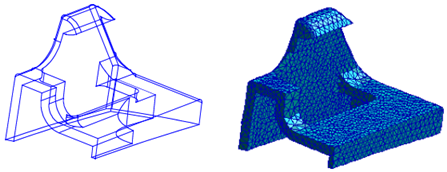XXXXXXXXXXXXXXXXXXXXXXXXXXXXXXXXXXXXXXXXXXXXXXXXXXXXXXXXXXXXXXXXXXXXXXXXXXXXXXXXXXXXXXXXXXXXXXXXXXXXXXXXXXXXXXXXXXXXXXXXXXXXXXXXXXXXXXXXXXXXXXXXXXXXXXXX''"> Overview of Meshing
Finite element modeling is central to the ability to perform an engineering analysis of a model using a computer. One of the core strengths of Patran is its ability to help you create a finite element model, either from an existing geometry model or through direct finite element operations.
The equations needed to determine the behavior of an entire complex model are often so complicated that it would be impractical to derive or solve them. The finite element method solves this problem by dividing the complex model into an assembled group of finite elements, small interconnected pieces commonly referred to as a mesh. The elements in a finite element model have common geometric shapes such as rectangles, triangles, and tetrahedra. They also include connecting points called nodes, and assigned material and element properties.
Once the model is divided into finite elements, the computer analysis program can then use efficient mathematical equations to calculate the behavior of the individual elements, taking into account the interdependence of adjacent elements and the assigned properties. By converting the geometry model into a finite element model composed of interconnected pieces, a computer can analyze the model’s behavior simply and accurately.
Figure 5‑1 A geometry model versus a finite element representation
In many structural analyses, for example, each element is viewed as a set of springs. These springs are attached at their corner points (known as nodes) to provide an interdependent representation of the entire model's behavior. Mathematically, this is accomplished by having each element contribute terms which are combined to form a matrix of constants known as a stiffness matrix. This matrix is combined with the mass, material, and other properties of these elements to form a global matrix [k]. The global matrix then becomes part of a matrix equation that relates the loads {P} with the resulting displacement {d}, as shown:
{P} = [k]{d}
The analysis program solves this equation to produce displacements. These displacements are then used to compute other behaviors such as stress and strain at points in the model. Depending upon the capabilities of your analysis program, you can also solve for other behaviors such as thermal or acoustic properties, using similar matrix equations describing these behaviors.
Finite Element Modeling Capabilities
Patran contains many capabilities to help you create the right kind of finite element mesh for your model, and the creation of finite elements may often be a highly automated process. For some models, even a single automated meshing operation, followed by another step to join mesh regions together, may suffice.
Patran provides the following capabilities for finite element modeling (FEM):
• Mesh seeding tools to control specific mesh densities in specific areas of your geometry.
• Several highly automated techniques for mesh generation.
• Equivalencing capabilities for joining meshes in adjacent regions.
• Tools to verify the quality and accuracy of your finite element model.
• Capabilities for direct input and editing of finite element data.
These tools help minimize the human effort needed to reach your most important goal--understanding the behavior of a geometric model--while providing the flexibility to have as much control over the process as you need.

